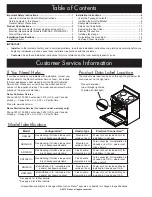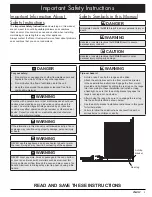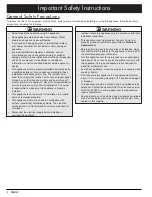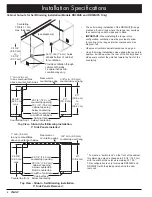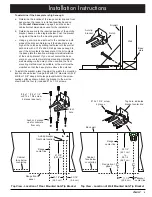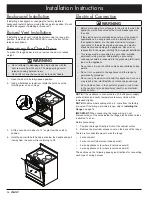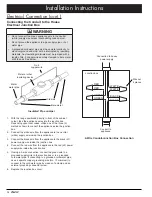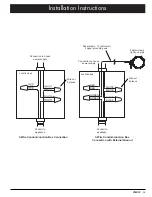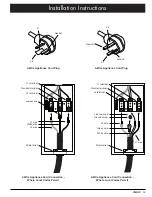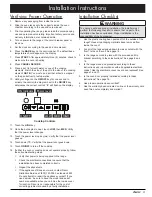
9
To determine if the base plate is high enough:
a. Determine the location of the range center line and front
panel when the range is in its final position based on
the
Product Dimensions
on page 4 and the actual
cabinet/cutout dimensions used for the installation.
b. Determine and mark the required position of the anti-tip
bracket, based on the diagram below. Push the bracket
up against the wall in the mounting location.
c. Using a pencil, make a dot next to the notches on both
sides of the bracket. Determine if the base plate is as
high at the notches by drilling test holes into the wall at
both dots with a 1/16” drill bit. Drill just deep enough to
see if the bit contacts the base plate. If the bit contacts
the base plate the location will support wall installation
of the anti-tip bracket. If you do not contact the base
plate, or you contact metal stud mounting materials, the
wall mounting method may not be used and the floor
mounting method must be suitable, or the wall must be
modified so that the base plate is above the notches.
4. To install the bracket, place it against the wall in the mounting
location shown below. Using a drill with 1/8” diameter drill bit,
drill four 1 5/8” deep pilot holes perpendicular to the screw
seating surfaces shown. Attach the bracket to the wall as
shown with the four (4) included #12 x 1 3/4 screws.
Installation Instructions
Drywall
Notch
Wall
Anti-tip
bracket
Base
plate
Top View - Location of wall Mounted Anti-Tip Bracket
CL
CL
Range
center line
#12 x 1 3/4” screw,
4 places
Range front
panel
Bracket
center line
Back wall
11 1/2”
(29.2 cm)
25 1/4”
(64.1 cm)
to
26 1/4
(66.7 cm)
Cabinet
face below
countertop
Top hole, indicates
bracket center line
Top View - Location of Floor Mounted Anti-Tip Bracket
CL
#8 x 1”, #8 x 1 1/4”
or #12 x 1 3/4 screw,
4 places (see text)
Range front
panel
Range
center line
2 3/16”
(5.6 cm)
10 1/2”
(26.3 cm)
21 3/8”
(54.3 cm)
Anchor, 4 places:
use for concrete
floor only
Front
hole
Cabinet
face below
countertop
Anti-tip bracket
front hole locations


